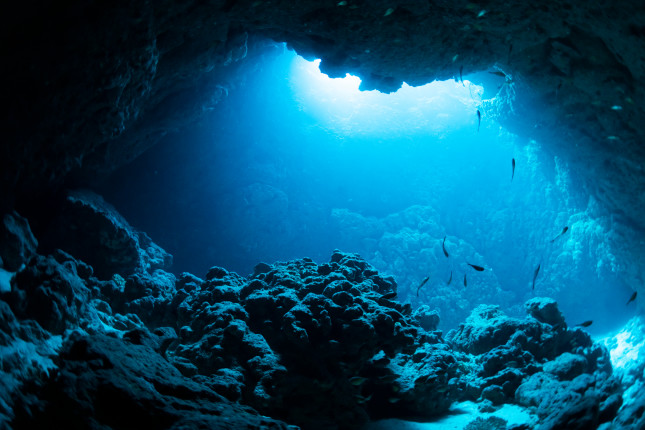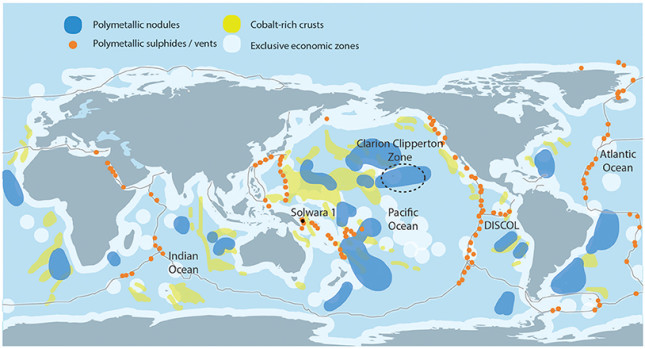-
Deep Seabed Mining and the Green Energy Transition
May 31, 2022 By David Michel
On March 8, 2022, the price of nickel doubled overnight. Fueled by the war in Ukraine, fears of supply disruptions briefly drove the cost of nickel contracts over $100,000-a-ton. The London Metal Exchange, the main global market for industrial metals, suspended trading for a week, canceling billions of dollars worth of trades.
Russian mines accounted for about 11 percent of global nickel production in 2020 and are also a leading source of the high-purity nickel sulfide ores required to produce electric vehicle (EV) batteries. International sanctions then had yet to target mineral exports directly. But as pressures grew to take stronger measures against Moscow’s war-making capacity, shippers and traders increasingly balked at dealing in Russian commodities. The March 2022 price jump pushed the cost of nickel in each EV to $1,750 per car. Before the end of the month, the International Energy Agency launched a critical minerals security program to ensure the stability of clean technology supply chains.
The war in Ukraine throws the geopolitics of the green energy transition into stark relief. Russia is the world’s largest exporter of natural gas and third largest supplier of oil. Moscow’s ability to leverage its grip on hydrocarbon supplies against opponents of its aggression in Ukraine underlines the political costs of continued global dependence on fossil fuels, boosting support for promoting renewable energy options. At the same time, Russia’s mineral resources remain an acute reminder that the materials necessary for green technologies are similarly susceptible to geopolitical risks.
Seeking to navigate between this Scylla and Charybdis, a growing number of policy analysts and practitioners see potential solutions to the green transition in the “blue growth” of ocean development. Mineral deposits on the sea floor, they maintain, could help meet green technology’s demands while avoiding the geopolitical dilemmas and environmental damages of exploiting land-based resources.
Race to the bottom?
The deep seabed—the ocean floor below 200 meters depth—contains many of the so-called “critical minerals,” such as lithium, zinc, and rare earth elements, essential to achieving the clean energy transition. The deposits occur in several different forms known as cobalt-rich crusts, polymetallic nodules, and polymetallic sulphides, and are widely distributed throughout the world’s oceans. The Clarion-Clipperton Zone alone, a Europe-sized area in the eastern Pacific, is estimated to hold more nickel, manganese, and cobalt than all land-based reserves combined. According to the World Bank, demand for critical minerals could surge 450 percent by 2050 if clean technologies are employed on the scale needed to meet the Paris Climate Agreement goal of holding climate change to 2o Celsius. As improving undersea exploitation techniques render seabed deposits more accessible, countries and companies are increasingly eyeing mineral development’s “last frontier”.
Proponents affirm that deep seabed mining (DSM) will deliver high-grade ores with fewer negative impacts than land-based mining. Terrestrial minerals extraction can generate significant social and environmental risks ranging from land degradation and water pollution to population displacements and human rights abuses. Deposits of several critical minerals are concentrated in a handful of countries, often in conflict-affected areas. Consequently, many observers fear that soaring world demand could fuel geopolitical competition to secure availability and fan further instability in vulnerable regions.
DSM, by contrast, can help alleviate such “security of supply” risks. Retrieving minerals from the sea floor would diversify sourcing, reducing reliance on production in China, Russia, and certain fragile states. Because substantial deposits lie within the Exclusive Economic Zones (EEZs) of some small island states, DSM could also provide some of the countries most vulvernable to climate change with much needed revenues. By the same token, advocates argue, since DSM takes place offshore and underwater, it largely obviates the social and environmental disruptions of mining on land.
Devils in the deep blue sea
In practice, seabed mining could prove neither economically viable nor environmentally sustainable. Economically, long-term demands for critical minerals are highly uncertain, depending upon rapidly evolving technology pathways, and could largely be met from existing global terrestrial reserves. Emerging innovations, such as battery technologies requiring fewer critical minerals, and circular economy models recycling raw materials, suggest the green transition can be realized without mining the seabed.
Environmentally, DSM poses considerable risks. Mining impacts could spread over hundreds of thousands of km2 of the ocean, devastating fragile marine fauna, damaging important habitat, and discharging harmful wastes. Especially worrisomely, DSM could stir up seafloor carbon sediments, releasing CO2 that could exacerbate ocean acidification and add to climate warming. DSM operations could also conflict with established environmental and economic assets including fisheries, marine protected areas, shipping lanes, and submarine cables and telecoms terminals. Yet very little of the deep ocean has been studied, leaving large knowledge gaps and scant baseline data from which to build meaningful impact assessments or effective management policies.
Developing DSM could also spawn new geopolitical tensions as major powers jockey to control seabed resources. Some analysts, for example, argue that China’s claims to the South China Sea reflect in part Beijing’s ambitions to assert sovereignty over the mineral deposits under those contested waters. Similarly, seabed minerals may help explain Chinese overtures to several Pacific island states, at times discomfiting nations that consider the region their backyard. China’s neighbors likewise worry that Chinese DSM exploration in the Indo-Pacific furnishes Beijing with “dual use” knowledge—such as underwater surveillance and topographical mapping—that could be adapted to military advantage. Mining activities, in turn, could be used to justify greater Chinese naval presence in the region.
Governing the gold rush
National authorities are responsible for regulating DSM within their EEZs. In areas beyond state jurisdiction, the UN Convention on the Law of the Sea (UNCLOS) established the International Seabed Authority (ISA) to manage mineral resources activities “for the benefit of mankind as a whole,” including the equitable sharing of economic benefits derived from developing the seabed. Even so, national and international DSM policies remain in their infancy. To date ISA has accorded 31 exploration contracts covering over 1.3 million km2 of seafloor, most to state-backed companies. A few countries have issued exploration licenses within their EEZs. But there are currently no fully active commercial DSM projects.
This may soon change. In June 2021, Nauru, a small Pacific island state, informed the ISA of its intent to start mining, triggering a clause in UNCLOS requiring ISA to finalize regulations within two years of such an announcement or allow mining to proceed under whatever rules are then in place. Following delays due to the pandemic, ISA has resumed negotiations to forge the necessary frameworks. Many stakeholders, though, condemn the deliberations’ lack of transparency as ISA’s legal and technical commission meets behind closed doors. Environmental protections, too, are meant to be part of the process, but ISA possessses little monitoring or enforcement capability. With no ocean-going vessels or submersibles at its disposal, ISA’s Secretary General acknowledges it cannot adequately supervise seabed activities and “will need to significantly upscale its regulatory capacity in the coming years.”
Whether Nauru or any other country will ultimately proceed with DSM is an open question. Past experience suggests reason for caution. Previously, the one commercial mining operation so far to receive approval collapsed in 2019 in the face of civic opposition and financial difficulties. Businesses such as Google, Samsung, BMW, and Volvo have committed not to source minerals from the seabed, and several small island states support a 10-year moratorium on DSM to allow for further research.
Look before leaping
Rather than the springboard for an incipient resource bonanza or impending great power confrontation, DSM now appears clouded in economic, environmental, and regulatory uncertainty. Whether and how any deep sea mineral gold rush will pan out, if at all, remains to be seen.
Achieving the green energy transition and averting the climate crisis will require critical minerals. Acquiring these minerals by DSM would entail trade-offs between the social and environmental benefits of the technologies they enable and the social and environmental risks of extracting resources from the ocean floor. At present, the international community possesses neither sufficient knowledge of the deep ocean environment to accurately assess those trade-offs nor adequate regulatory and institutional frameworks to manage mining the seabed. The world should not pursue DSM without them.
David Michel is a senior researcher with the Environment of Peace program at the Stockholm International Peace Research Institute (SIPRI) and a senior research fellow at the Center for Climate and Security.
Sources: Australian Journal of Maritime & Ocean Affairs, BP, Center for Strategic & International Studies, Elements, Energy Policy, Energy Strategy Reviews, Geographical, Inside Climate News, International Energy Agency, International Institute for Sustainable Development, International Seabed Authority, Journal of Environmental Management, Marine Ecosystem Ecology, Marine Policy, Marine Science and Engineering, Marine Technology Society Journal, Merriden Varrall (2021), Nature, Nature Communications, Ore Geology Reviews, Political Geography, Pure and Applied Chemistry, Science of the Total Environment, Reuters, Secretariat of the Pacific Regional Environment Programme, Science & Society, Sustainability, The Conversation, The Guardian, The New York Times, United Nations, U.S. Geological Survey.
Lede Image Credit: Rays of sunlight illuminate an underwater cave. Courtesy of divedog, Shutterstock.com.
Second Image Credit: K.A. Miller et al., “An overview of seabed mining including the current state of development, environmental impacts, and knowledge gaps,” Frontiers in Marine Science vol. 4 (Jan. 10, 2018).
 A Publication of the Stimson Center.
A Publication of the Stimson Center.




